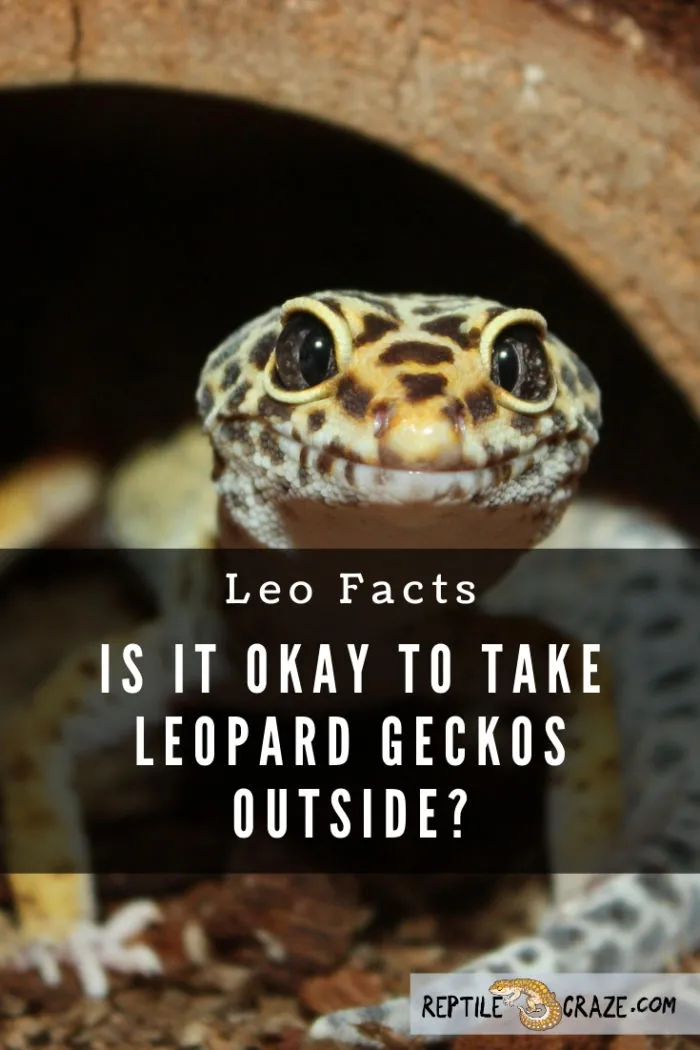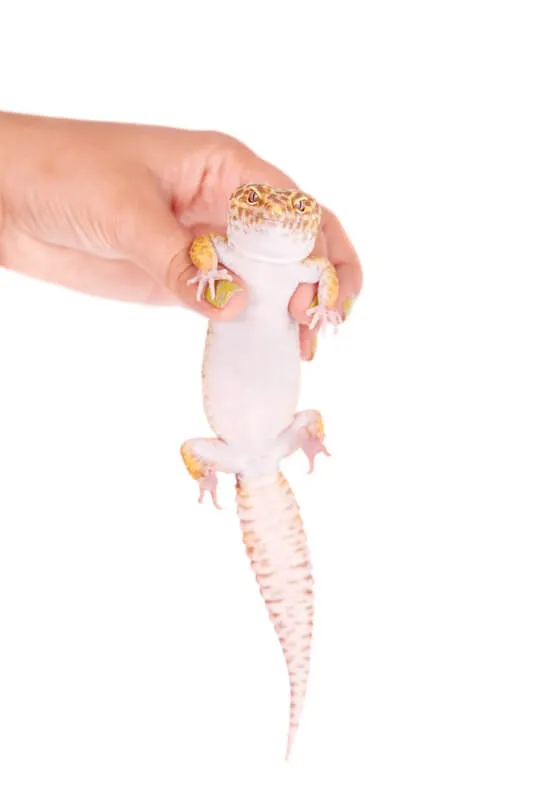 Going outside feels good- fresh air, sunlight, and just being in nature is good for everybody. What about your leopard gecko? If you took him outside, could something bad happen? Are there benefits?
Going outside feels good- fresh air, sunlight, and just being in nature is good for everybody. What about your leopard gecko? If you took him outside, could something bad happen? Are there benefits?
Can I Take My Leopard Geckos Outside? Yes, you can take your leopard gecko outside. However, taking them outside during the daytime hours is not a great idea because they are crepuscular animals. They prefer to be active during the dusk and dawn hours.
Now you know that it is OK to take your leopard gecko outside, but you have to be careful of the hours in which you do it. Keep reading to discover safety tips and ideas to keep your leopard gecko happy when outside.
Table of Contents
Work on Their Time
You will have to work with your leopard gecko’s schedule, not against it when taking your leopard gecko outdoors.
Leos are most active when many of us are getting ready to settle in for the evening. As a result, you may have to modify your schedule if you would like to take your leopard gecko outdoors.
Don’t Make Them Wake Up
It can be really tempting to wake up a leo to take them outside. After all, it’s a beautiful day out there. Why not make the most of it?
Don’t do this! Instead, make sure the leopard gecko is awake before you take them outside. These reptiles have to get their sleep, and if they don’t get enough, they tend to stress out, kind of like us humans.
Every creature big and small need their sleep, as it helps them be as healthy as possible.
You may think waking them up just once or twice to experience the great outdoors is not a bad idea, but the fact of the matter is that it is just not convenient for the leopard gecko.
Being a good owner means respecting their sleep times and knowing that in order to have a healthy and happy gecko, you have to let them sleep when THEY feel like it.
Just make sure you allow them to wake up, and then take them outside. Your gecko will be much happier that way.
Leos Can Run
Even though it may seem like your gecko loves to hang around and chill in the cool or moist hide during the day, these little guys are faster than you know.
The point we’re trying to make is, these reptiles can move fast. You will want to make sure you take steps so that the reptiles will not get away from you when you take them outdoors. These guys are great at moving fast when they want to.
So, what can you do to ensure they don’t get lost? First, make sure you get yourself a good reptile harness. You can find these on Amazon or even have one custom made for your gecko.
They are tiny and safe (not to mention comfortable) harnesses for your gecko that will let him freely explore without any worry on your part.
You can also place your gecko into an enclosure to keep them from running off. Sure, they may not get the full experience of touching the grass or the rocks outside, but it feels better to just play it safe sometimes.
Be Mindful of the Sun
Leopard geckos are not big on being in the direct sunlight. Yes, they like it hot. However, they don’t spend a LOT of time there.
They may get into it on occasion to get their Vitamin D3 for the day; aside from that, they really just enjoy being warm and are most often found being active during the darker hours of the day.
If left in the sun for too long, the leopard gecko could overheat. It is quite uncomfortable for them to be in direct sunlight. Thus, their exposure should be limited. Keep their exposure to a minimum- we’re talking no more than ten minutes at a time in the sunlight.
Yes, leopard geckos enjoy being in the warmth, but the sunlight is not like their heat lamps, which you regulate and keep track of every day. There are also no cool places to escape to when it gets too hot or hides to make use of, either.
Having no place to cool down is also stressful to the leopard gecko. Taking them outside should be done just for short stretches of time, and the leo should not be allowed to sit in the sun for too long.
Even though these reptiles are denizens of the desert and the conditions there are less than temperate, they still become very stressed out when it is too hot, and there are no places to hide out and cool down.
Be Careful of Outside Insects
Leopard geckos really love to eat insects. This we know from dropping crickets, roaches, and mealworms into their enclosure and watching them catch all the bugs.
Thus, taking your leopard gecko outside means being vigilant about what they eat while outdoors. The insects outside could be harmful to their health.
In their natural habitats, leopard geckos eat insects all the time. However, the ones that are found in urban environments, and even rural ones with farming communities, could be the harbingers of pesticides.
Bugs become the carriers of pesticides when they land on or eat grass/dirt that has been treated. It can make your leo quite sick if you are not careful.
It’s important to keep a very close eye on your gecko because even small insects like aphids or ants can be consumed without you even noticing. You won’t even see them do it. Millions of insects in your state or province alone ensure this.
Your best bet is to try and make sure your leopard gecko is always in your sight, or on a surface where bugs are least likely to roam. It is another reason some owners enjoy having their gecko in an enclosure when they go out.
Watch for Predators
Even though you might not think there are predators where you live, think again. There are animals that you have to watch out for that are waiting to swoop in and take your leopard gecko for their lunch.
As a result, your job is to make sure that you are keeping watch over your gecko and keep them safe and sound as you take them outside. Let’s look at some examples of predators to watch out for.
Predators in the Wild
Hedgehogs and mice are known to feed on geckos, which may surprise you. Stoats, ferrets, and weasels are other examples of predators that will feed on geckos. Rats and opossums will eat geckos as well. Even birds like owls are known to be eaters of geckos.
You will not likely have to worry about this because you are keeping a close watch on your leopard gecko. But it is important to know about these things, so you know what to watch out for.
Humans
Your family knows about your leopard gecko, and they’re not going to hurt him. However, other humans may see your gecko as a cute little treasure they will keep for themselves. Be careful to keep a close eye on your leo, so he doesn’t run off only to be stolen by a human.
You will also want to make sure that your leo is not surrounded by humans while outside, as this can be more stress in an already stressful scenario.
Other Pets
Your cats, dogs, chickens, and other pets that live or play outdoors probably have no intention of harming your leopard gecko. However, they may play with the reptile or sniff at it, which could stress out your gecko.
Some animals like dogs can play a little too rough and end up harming or even killing your leopard gecko. Make sure that when you take your leo outside, they are safely in their enclosure or kept away from other pets who may also be roaming outside.
Your pets likely are simply curious and have no intention to harm, but it is best to play it safe.
Be Mindful of Injuries
If you end up with a small cut or scrape when going outdoors, it’s not a big deal. A bandage and some peroxide, and you’re all set to heal. However, it’s different when you are a leopard gecko.
Even though these critters are pretty scaly little guys, their bodies could still be injured if an object outside is quite sharp. Even things we don’t think of as being sharp can still be dangerous to a leopard gecko.
Pine needles, glass shards, and even thistle weeds are just a few of the hazards, not to mention sticks and sharp rocks.
Make sure you are being very mindful of your leopard gecko’s well-being when you take them outdoors. Make sure to clear out any hazards or avoid areas where sharp or dangerous objects could be located.
If your backyard or outside area has too many of these items to note, such as an abundance of rocks or sticks, it may be best to put them in an enclosure when heading outside.
Conclusion
It’s OK to take your leopard gecko outside (if it’s not too cold)– you just have to be very careful about how you do it. It is a good idea to have an enclosure on hand so you can keep watch on them at all times.
A portable enclosure is also good for vet visits, cleaning the cage, and walking your gecko around the house to visit with other family members.
Having a harness is also a must if you would like to let your leopard gecko walk through the grass. Not having one of these helpful harnesses will almost guarantee your gecko to run off.
Make sure you shop on Amazon or look online for an independent seller who can ensure your leopard gecko gets a harness that is just right.
Keep your outdoor visits short, especially when in the sun. Even though these reptiles love the heat, direct sunlight is a stressor for them. Lastly, make sure you only take them out when THEY feel ready to come, not by waking them up and dragging them outside.
Enjoy this time with your leopard gecko-and keep him safe!
- Enchi Ball Python: A Unique and Stunning Morph of Python regius - March 27, 2025
- Emerald Tree Monitor: The Enigmatic Green Guardian of the Rainforest - March 26, 2025
- The Egyptian Cobra (Naja haje): A Fascinating Serpent - March 25, 2025
